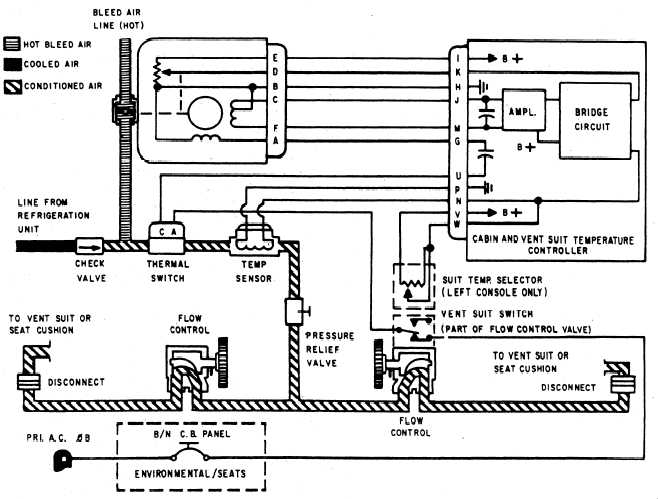by cockpit equipment and resulting high-
temperature ambient air.
Some vent-air systems, such as the one
installed in the A-4 model aircraft, supply air to
only one individual and operate on a small
independent motor-driven air blower. Most newer
aircraft use engine bleed air that has been cooled
in the aircraft’s air-conditioning system auxiliary
heat exchanger as a primary source of ventilation
air. A schematic of the A-6 aircraft vent-air system
that operates off engine bleed air is illustrated in
figure 1-6.
The A-6 vent-air system is supplied cooled
bleed air from the refrigeration unit of the
aircraft’s cabin air-conditioning and pressuriza-
tion system and hot bleed air from the
hot bleed-air ducting just downstream of the
engine bleed-air shutoff valve. The hot and cold
bleed-air lines converge into one conditioned air
duct that is connected directly to the pilot’s and
bombardier/navigator’s flow controllers and the
personnel services disconnect.
Temperature control of the vent-air system is
regulated between 50°F and 100°F by the vent suit
temperature selector, the temperature control
valve, a temperature sensor, and the cabin and
vent suit temperature controller. The components
of the temperature control system cause the
temperature control valve to cycle between open
and close. Thus, temperature control is main-
tained by governing the flow of hot engine bleed
air that is being mixed with cool air from the
refrigeration unit.
The vent-air system is turned on by the vent
suit switch. This switch is an integral part of the
pilot’s flow controller. When the flow control
valve thumbwheel is rotated slightly from the OFF
position, the circuit between the temperature
sensor and the cabin and vent suit controller is
completed. The controller responds to signals
Figure 1-6.—Vent-air system.
1-6


